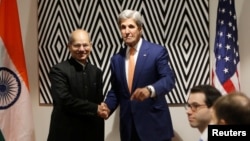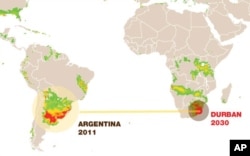Delegates at a climate conference in Rwanda are expressing optimism that they will reach a deal to phase out greenhouse gases used in refrigerators and air conditioners.
U.S. Secretary of State John Kerry told reporters at the conference in Kigali Friday that countries may agree on different deadlines for ending use of the gases, raising hopes of a breakthrough on the issue.
The United States and other Western countries want to begin eliminating the use of hydrofluorocarbons (HFCs) in 2021, while other nations, such as India, want to move at a slower place, starting reductions after 2030.
“No country has a right to turn its back on this effort and to forget about the meaning of a multilateral effort,” Kerry said.
Experts say that banning HFCs, also used in aerosols, could slow the rise in the global temperature by half a degree by the end of the century.
“If we’re going to give this amendment the teeth it needs to prevent as much as a half-degree of warming, then we need to make sure we’re pushing for the most far-reaching amendment we can adopt,” Kerry said.
Stephen Ndegwa of the Center for Climate Change Awareness in Kenya says Africa cannot afford to repeat the mistakes of developed nations and send pollutants into the atmosphere.
“We are adopting a lot of new technologies because we are a new growth market for China and the West,” he said. “It means we are purchasing a lot of technologies that have the capacity to affect our environment, so it comes at a critical time so that we avoid the mistakes that the developed countries may be made on their way to achieving their status.”
HFCs, although less plentiful than carbon dioxide, can have an effect that is thousands of times that of an equal volume of carbon dioxide when released into the atmosphere. The hazards of HFCs have multiplied as sales of air conditioners and refrigerators have soared in emerging economies like India and China.
HFCs replaced chlorofluorocarbons (CFCs), which were discontinued under the 1987 Montreal Protocol when scientists found out they were destroying the ozone layer.
Paul Newman is the co-chair of the scientific panel on the Montreal Protocol at the conference. He says the agreement to reduce CFCs created a market for HFCs.
“Now they are looking at what can they do to help control the climate change by HFCs,” he said. “So at the moment, what they are trying to do here in Kigali, Rwanda, is creating an amendment to the Montreal Protocol. It can control HFCs, so this is a big leap for the Montreal Protocol.
Whatever is agreed to in Kigali will complement other pacts made to reduce global warming, such as the Paris agreement that was signed in December.









